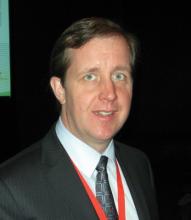CHICAGO – Pacemaker-detected asymptomatic atrial high-rate episodes in patients with no history of atrial fibrillation were associated with a 2.5-fold increased risk of subsequent ischemic stroke or systemic embolism in the large, multicenter ASSERT study.
These device-detected asymptomatic episodes of atrial tachyarrhythmia are quite common in pacemaker recipients who have no history of atrial fibrillation. Indeed, 36% of the 2,580 participants in ASSERT (Asymptomatic Atrial Fibrillation and Stroke Evaluation in Pacemaker Patients and the Atrial Fibrillation Reduction Atrial Pacing Trial) had at least one such episode lasting for more than 6 minutes at an atrial rate of greater than 190 minutes during a mean 2.8 years of follow-up. Among the minority of patients who were followed out to 5 years, the rate was 50%, Dr. Jeff S. Healey reported at the annual scientific sessions of the American Heart Association.
The primary outcome in ASSERT was the incidence of ischemic stroke or systemic embolism. This occurred at a rate of 0.69% per year in patients with no device-detected atrial high-rate episodes (AHREs), and 1.61% per year in those with one or more such episodes, for a 2.5-fold increased risk, said Dr. Healey of McMaster University in Hamilton, Ont.
In the ASSERT population with no history of atrial fibrillation, 35% of all strokes or systemic emboli were preceded by at least one episode of device-detected AHRE.
The incidence of clinical atrial fibrillation or atrial flutter (a secondary end point) was 1.22% per year in patients without AHREs and 6.29% per year in those with an AHRE, for a 5.6-fold increased relative risk.
Eliminating from consideration those patients who developed clinical atrial fibrillation or atrial fibrillation as documented by surface ECG did not substantially change the study results, he added.
Among the roughly 80% of ASSERT participants with a baseline CHADS2 score of at least 2, the incidence of ischemic stroke or systemic embolism was 0.7% annually in those without an AHRE and 2.14% per year in those with an AHRE, for a 2.67-fold increased relative risk. This 2.1% per year stroke rate warrants physician attention, the cardiologist said.
"The risk of stroke among patients with device-detected atrial tachyarrhythmias and a CHADS2 score of 2 or more is similar to that in patients with atrial fibrillation, where guidelines recommend physicians begin to consider use of oral anticoagulation," Dr. Healey noted.
ASSERT participants averaged 76 years of age. In all, 15% had heart failure, 28% had diabetes, and 7% had a history of stroke.
Discussant Dr. John Camm said that ASSERT has important clinical ramifications, including the need to consider oral anticoagulation therapy for stroke prevention in pacemaker patients with no history of atrial fibrillation if their device records an AHRE lasting for more than 6 minutes in excess of 190 beats per minute. What to do about lesser episodes remains a question for the future.
Physicians will have to wait another 4 years for the next major developments regarding pacemaker-detected AHREs. The year 2014 will bring results from Biotronik’s 2,718-patient IMPACT trial, in which patients with episodes of atrial tachyarrhythmia detected by home monitoring will be placed on anticoagulation, as well as St. Jude Medical’s 5,000-patient RATE registry, said Dr. Camm, professor of cardiology at St. George’s, University of London.
The ASSERT study was sponsored by St. Jude Medical. Dr. Healey disclosed serving on the advisory boards of Sanofi-Aventis and Boehringer Ingelheim.


